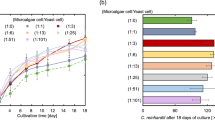Abstract
Saccharomyces cerevisiae can be engineered to ferment cellodextrins produced by cellulases as a product of cellulose hydrolysis. Direct fermentation of cellodextrins instead of glucose is advantageous because glucose inhibits cellulase activity and represses the fermentation of non-glucose sugars present in cellulosic hydrolyzates. To facilitate cellodextrin utilization by S. cerevisiae, a fungal cellodextrin-utilizing pathway from Neurospora crassa consisting of a cellodextrin transporter and a cellodextrin hydrolase has been introduced into S. cerevisiae. Two cellodextrin transporters (CDT-1 and CDT-2) were previously identified in N. crassa, but their kinetic properties and efficiency for cellobiose fermentation have not been studied in detail. In this study, CDT-1 and CDT-2, which are hypothesized to transport cellodextrin with distinct mechanisms, were introduced into S. cerevisiae along with an intracellular β-glucosidase (GH1-1). Cellobiose transport assays with the resulting strains indicated that CDT-1 is a proton symporter while CDT-2 is a simple facilitator. A strain expressing CDT-1 and GH1-1 (DCDT-1G) showed faster cellobiose fermentation than the strain expressing CDT-2 and GH1-1 (DCDT-2G) under various culture conditions with different medium compositions and aeration levels. While CDT-2 is expected to have energetic benefits, the expression levels and kinetic properties of CDT-1 in S. cerevisiae appears to be optimum for cellobiose fermentation. These results suggest CDT-1 is a more effective cellobiose transporter than CDT-2 for engineering S. cerevisiae to ferment cellobiose.





Similar content being viewed by others
References
Arendt CS, Ri K, Yates PA, Ullman B (2007) Genetic selection for a highly functional cysteine-less membrane protein using site saturation mutagenesis. Anal Biochem 365:185–193
Bhat KM, Gaikwad JS, Maheshwari R (1993) Purification and characterization of an extracellular β-glucosidase from the thermophilic fungus Sporotrichum thermophile and its influence on cellulase activity. J Gen Microbiol 139:2825–2832
Bohlin G, Praestgaard E, Baumann MJ, Praestgaard J, Monrad RN, Westh P (2013) A comparative study of hydrolysis and transglycosylation activities of fungal β-glucosidases. Appl Microbiol Biotechnol 97:159–169
Cussler E, Aris R, Bhown A (1989) On the limits of facilitated diffusion. J Membr Sci 43:149–164
Galazka JM, Tian CG, Beeson WT, Martinez B, Glass NL, Cate JHD (2010) Cellodextrin transport in yeast for improved biofuel production. Science 330:84–86
Giuliani F, Grieve A, Rabouille C (2011) Unconventional secretion: a stress on GRASP. Curr Opin Cell Biol 23:498–504
Ha SJ, Galazka JM, Kim SR, Choi JH, Yang XM, Seo JH, Glass NL, Cate JHD, Jin YS (2011) Engineered Saccharomyces cerevisiae capable of simultaneous cellobiose and xylose fermentation. Proc Natl Acad Sci U S A 108:504–509
Ha SJ, Kim H, Lin YP, Jang MU, Galazka JM, Kim TJ, Cate JHD, Jin YS (2013) Single amino acid substitutions in HXT2.4 from Scheffersomyces stipitis lead to improved cellobiose fermentation by engineered Saccharomyces cerevisiae. Appl Environ Microbiol 79:1500–1507
Haki G, Rakshit S (2003) Developments in industrially important thermostable enzymes: a review. Bioresour Technol 89:17–34
Hosaka K, Nikawa J, Kodaki T, Yamashita S (1992) A dominant mutation that alters the regulation of INO1 expression in Saccharomyces cerevisiae. J Biochem 111:352–358
Kumar R, Singh S, Singh OV (2008) Bioconversion of lignocellulosic biomass: biochemical and molecular perspectives. J Ind Microbiol Biotechnol 35:377–391
Lynd LR, Weimer PJ, Van Zyl WH, Pretorius IS (2002) Microbial cellulose utilization: fundamentals and biotechnology. Microbiol Mol Biol Rev 66:506–577
Nombela C, Gil C, Chaffin WL (2006) Non-conventional protein secretion in yeast. Trends Microbiol 14:15–21
Park TH, Choi KW, Park CS, Lee SB, Kang HY, Shon KJ, Park JS, Cha J (2005) Substrate specificity and transglycosylation catalyzed by a thermostable β-glucosidase from marine hyperthermophile Thermotoga neapolitana. Appl Microbiol Biotechnol 69:411–422
Postma E, Scheffers WA, Van Dijken JP (1989) Kinetics of growth and glucose transport in glucose‐limited chemostat cultures of Saccharomyces cerevisiae CBS 8066. Yeast 5:159–165
Santos E, Rodriguez L, Elorza M, Sentandreu R (1982) Uptake of sucrose by Saccharomyces cerevisiae. Arch Biochem Biophys 216:652–660
Shapouri H, Salassi M, Fairbanks J (2006) The economic feasibility of ethanol production from sugar in the United States. Tech. Rep., U.S. Department of Agriculture, Baton Rouge, LA
Shen Y, Zhang Y, Ma T, Bao X, Du F, Zhuang G, Qu Y (2008) Simultaneous saccharification and fermentation of acid-pretreated corncobs with a recombinant Saccharomyces cerevisiae expressing β-glucosidase. Bioresour Technol 99:5099–5103
Sikorski RS, Hieter P (1989) A system of shuttle vectors and yeast host strains designed for efficient manipulation of DNA in Saccharomyces cerevisiae. Genetics 122:19–27
Spiro S, Guest JR (1991) Adaptive responses to oxygen limitation in Escherichia coli. Trends Biochem Sci 16:310–314
Weusthuis RA, Adams H, Scheffers WA, Van Dijken J (1993) Energetics and kinetics of maltose transport in Saccharomyces cerevisiae: a continuous culture study. Appl Environ Microbiol 59:3102–3109
Wyman CE (2007) What is (and is not) vital to advancing cellulosic ethanol. Trends Biotechnol 25:153–157
Acknowledgments
This work was supported by funding from the Energy Biosciences Institute (EBI) to Yong-Su Jin and Jamie Cate.
Author information
Authors and Affiliations
Corresponding author
Rights and permissions
About this article
Cite this article
Kim, H., Lee, WH., Galazka, J.M. et al. Analysis of cellodextrin transporters from Neurospora crassa in Saccharomyces cerevisiae for cellobiose fermentation. Appl Microbiol Biotechnol 98, 1087–1094 (2014). https://doi.org/10.1007/s00253-013-5339-2
Received:
Revised:
Accepted:
Published:
Issue Date:
DOI: https://doi.org/10.1007/s00253-013-5339-2




